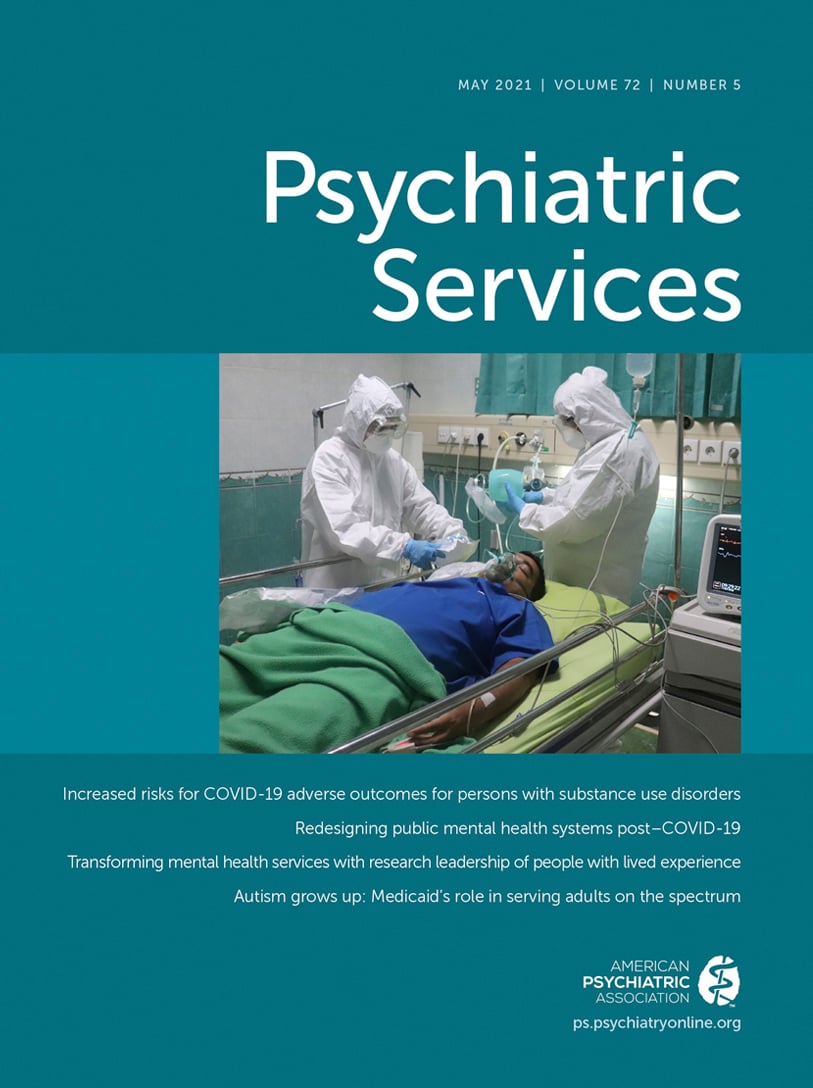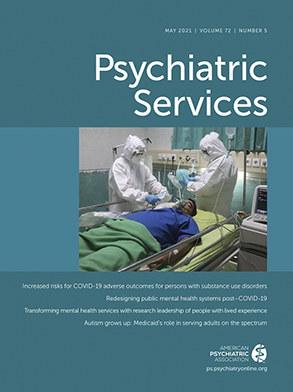During the COVID-19 pandemic, frontline health care workers are suffering from unprecedented levels of stress, anxiety, and depression (
1). Most hospital systems around the world have acted swiftly to address and mitigate these negative psychological effects, creating various mental health services, such as hotlines, debriefs, and relaxation centers, to support frontline workers. To better understand whether these services were effective, we conducted an extensive literature review on mental health interventions during disease outbreaks. As we soon discovered, research is lacking on effective interventions to improve frontline workers’ mental health, and even fewer studies focus specifically on the mental health of nonclinical frontline workers, such as service workers.
Service workers—water, sanitation, and hygiene staff; transport workers; security personnel; food service workers; technicians; and countless other essential staff members—comprise a significant proportion of hospital employees. In our review, only three out of 10 studies included these nonclinical staff in their research on effective mental health interventions during disease outbreaks for frontline health care workers (
2–
4), and only two specified exactly who the nonclinical workers were, identifying them as “water, sanitation, and hygiene staff” or “domestic assistant and porter.” Service workers are not immune to the mental distress and trauma of serving on the front lines, and, therefore, support interventions that specifically attend to the unique needs of service workers must be established.
In this Open Forum, we describe the demographic characteristics of this neglected population, explore how structural racism plays a role in the lack of support interventions for service workers, closely examine the relationship between social determinants of health and COVID-19–related morbidity and mortality within this population, and make a plea for institutions to more deeply consider how they support their often unseen service workers.
Demographic Characteristics of Service Workers
Low-income earners, migrants, and people of color (including Black, Latinx, Pacific Islander, and Asian people) are overrepresented in the U.S. frontline health care service industry. For example, among facility cleaning service workers, 56.6% are non-White (a majority of whom are Latinx), 38.2% are foreign born, 42.4% earn below 200% of the poverty line, and 29.1% have no health insurance. Among custodial workers, 62.5% are non-White, 40.7% are foreign born, and 47.3% earn below 200% of the poverty line. Among medical assistants, 50.1% are non-White, 15.3% are foreign born, and 26.8% earn below 200% of the poverty line (
5). Additionally, among all hospital personnel with high-risk comorbid conditions who directly interact with patients, 7.5% are uninsured, 8.8% are unable to afford medications, 25.3% are worried about medical costs, and 28.6% lack paid sick leave (
6).
The Role of Structural Racism
These service workers, who are disproportionately low-income earners and people of color, are being excluded from mental health support interventions for frontline health care workers. We believe that their exclusion is in part due to structural racism—racial discrimination that operates at a societal level through bias in legislation and law enforcement and that advantages the racial majority while limiting access to opportunities and resources for people of color (
7). U.S. institutions have a deplorable record of structurally racist practices in their histories. This record includes Jim Crow–era employment laws that protected White workers and prohibited workers of color from unionizing (
8); racism and xenophobia institutionalized into the Fair Labor Standards Act, which guaranteed a minimum wage to all employees in the United States except for predominantly immigrant farm workers (who are now guaranteed minimum wage but excluded from overtime pay) (
8); and the Department of Labor classifying home health care work agencies, whose employees are primarily women of color, as independent contractors, excluding their employees from paid sick leave protections and other benefits guaranteed by the Fair Labor Standards Act (
9).
With structural racism embedded in our society and everyday life, it is not surprising that support initiatives outside of the hospital system have also been tailored to clinical staff and have excluded service workers. These initiatives have included health care worker discounts, the daily applause for health care staff, military flyovers for health care workers, free temporary housing and child care for physicians and nurses, and exemption from lines in grocery stores exclusively for physicians and nurses. As effective mental health support services for frontline staff are mobilized and secured during the COVID-19 pandemic, we argue that more needs to be done to understand the needs and experiences of these often ignored frontline service workers so that every worker feels supported and recognized, regardless of their position or status.
Interplay Between Social Determinants of Health and COVID-19
The first step in understanding the specific needs of service workers is to examine the burden of economic and social inequalities faced by people of color, which include inadequate education and living conditions, increased environmental exposures, and bias and discrimination. During normal working conditions, Black people have reported more frequent discrimination than any other racial group. Workplace racial discrimination, such as exclusion of service workers from emotional support services, has been found to induce psychological distress and depression (
10). These inequalities and biases have been aggravated by the COVID-19 pandemic. In fact, people of color have perceived increased discrimination during the pandemic and, as a result, feel higher levels of baseline stress (
11). Additionally, Black and Latinx communities are suffering from higher infection and mortality rates from COVID-19 in comparison with White and Asian populations, generating valid fears about acquiring the virus among people in these communities. In the United States, Black people alone accounted for 33% of COVID-19 hospitalizations, despite representing only 13% of the population (
12). Additionally, during the peak of virus transmission in New York City, the U.S. epicenter of the pandemic in the spring and early summer of 2020, age-adjusted confirmed COVID-19 deaths were 220 and 230 per 100,000 people among Black and Latinx patients, respectively, twice the mortality rate for White and Asian patients (
13). In a qualitative survey of 244 primarily Latinx immigrants across cities in New York State, well over 58% of respondents had been sick or had a family member become sick, and 16% had lost a family member because of the virus (
14).
Causes for the higher COVID-19 morbidity and mortality rates among people of color include the economic and social inequalities mentioned above, in conjunction with a higher likelihood of additional factors: having comorbid conditions such as asthma, heart disease, and diabetes; cohabiting in extended multigenerational homes; lacking the privilege of working from home because of employment in jobs that are deemed “essential”; having to take public transportation; and being unable to adhere to social distancing guidelines because of living and employment conditions (
15). Overall, fewer than one in five Black workers and one in six Latinx workers can work exclusively from home (
16). These inequitable factors illuminated by the COVID-19 virus amplify the risk for mental distress in people of color, a population that is overrepresented in the frontline service industry.
Taken together, service workers who are disproportionately people of color face serving on the front lines as unseen heroes, economic and social inequalities, and higher rates of COVID-19 related morbidity and mortality. It is of no surprise then that these workers endure unequivocal stress and trauma in the face of the COVID-19 pandemic.
Call to Action
Many people serving on the front lines of the COVID-19 pandemic are overlooked; it is our duty as society to look at ourselves in the mirror and examine how we attend to the needs of people of color within our own institutions. The compounding burdens faced by frontline service workers (including water, sanitation, and hygiene staff; transport workers; security personnel; food service workers; and technicians) need to be understood by hospital leadership and hospital communities. In alignment with the American Psychiatric Association’s apology in 2021 for its contributions to structural racism in the nation and with its pledge to enact antiracist practices, we, as mental health practitioners, believe it is necessary to uproot the structural racism that is undoubtedly affecting distribution of support for frontline service workers.
Hospital leadership, directors of emotional support services for frontline workers, and society at large can take a variety of actionable steps. First, we as leaders, must consider that many frontline service workers are low-income earners and people of color and therefore should be receiving adequate economic support, including hazard pay. Second, we must ensure that all members of our hospital communities responding to COVID-19 have paid sick leave, including third-party contracted hospital employees. Third, we know many frontline service workers live in multigenerational households where they cannot physically distance. Service workers must be offered the same benefits of free temporary housing and free child care that doctors and nurses receive. Fourth, on a daily basis, frontline service workers are victims of racist, sexist, and classist interpersonal and structural discrimination, which have been exacerbated by COVID-19. Hospitals need to offer support groups for frontline service workers of color and reparative truth and reconciliation practices to heal the wounds of racial traumas. Finally, emotional support services and research about frontline workers’ mental health should intentionally include frontline service workers in their support services and analyses.
Finally, to develop the most relevant mental health interventions during the COVID-19 pandemic, we, as leaders of emotional support services, must collaborate with frontline service workers to understand their individual difficulties and needs. We have considered revising support services within our own hospital system in the following ways: alter hours to provide services in the late night and early mornings, when many custodial and security staff are on duty; expand language capacity to offer services in the dominant languages of frontline service workers; provide culturally diverse and culturally appropriate emotional support options; ensure accessibility of all services by communicating their availability through relevant channels and offering services in locations where frontline service employees work; and offer grief support services to frontline service workers who are plagued by two pandemics: COVID-19 and racism.

